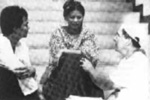Mario O'Hara
Ask anyone to recite the names of the great Filipino filmmakers of the'70s and the names Lino Brocka and Ishmael Bernal will come up; if they think a little harder they might throw in Celso Ad. Castillo, Mike De Leon, and perhaps Eddie Romero with his "Ganito Kami Noon, Paano Kayo Ngayon," (We Were Thus Then; How Are You Now? 1976) or Lupita Aquino-Kashiwahara, with her "Minsa'y Isang Gamu-Gamo" (Sometimes A Moth, 1976). Rarely, if ever, does the name Mario O'Hara crop up. Yet he was as much a force in the seventies as any of these names, and in a perhaps wider and more varied range of guises. He wrote the screenplay for two of Brocka's best works - "Insiang" (1976), and "Tinimbang Ka Ngunit Kulang" (You Were Weighed and Found Wanting, 1974), incidentally giving a great performance in "Tinimbang" as Berto, the town leper. He acted in Brocka's Jacobean melodrama "Stardoom" (1972), another great performance, and wrote a
screenplay (the "Hello Soldier" segment), not to mention acting in the "Bukas, Madilim, Bukas" (Tomorrow, Darkness) segment for Brocka's omnibus film "Tatlo, Dalawa, Isa" (Three, Two, One, 1974).
He wrote and directed at least three major works during this period. His first film, "Mortal" (1975), is about a man who goes insane and kills his wife. O'Hara tells the story backwards, starting from the man's time in a mental asylum - his head full of bizarre fantasies - to his eventual recovery and recollection of the murder. For his second project O'Hara was given a big-budgeted historical epic, starring popular actress Nora Aunor as a young girl struggling to survive during the Japanese Occupation. "Tatlong Taong Walang Diyos" (Three Years Without God, 1976) represented a quantum leap in scope and filmmaking skill for O'Hara, is regarded as his finest film, and possibly one of the finest Filipino films ever made. For his third project O'Hara wrote and directed most of "Mga Bilanggong Birhen" (The Captive Virgins, 1977), but left before shooting ended; the picture was finished without him. The film, about women surviving oppression in a patriarchal family, achieves moments of intense feeling and lyricism despite its unpolished state.
Among Filipino filmmakers, there is a subgenre of films where the filmmaker tries to create his version of Manila as a lower circle of Hell; examples range from Brocka's classic "Maynila sa Kuko Ng Liwanag" (Manila in the Claws of Neon, 1975) to Ishmael Bernal's "Manila By Night" (1980). From 1984 to 1986, O'Hara directed not just one but a trilogy of films about Manila: "Condemned" (1984) is a noir thriller about a brother and sister and the matriarchal gang lord that wants them both dead; "Bulaklak sa City Jail" (Flowers of the City Jail, 1985) is about a pregnant woman in the Manila City Jail; "Bagong Hari" (The New King, 1986) is an intensely nihilistic action film about a professional killer who takes revenge on the people who wronged him.
In 1998, O'Hara wrote and directed a pair of films: "Babae Sa Bubungang Lata" (Woman on a Tin Roof) is O'Hara's elegy to the Filipino film industry, a heartfelt celebration of what it once was and a scathing critique of what it is now. Shot in ten days and made for a mere 2.5 million pesos ($60,000), the film's technical flaws actually become its style - as if the poor, desperate people the film is about had actually made the film. His "Sisa" is possibly the most radical reinterpretation of Philippine national hero Jose Rizal yet made, with Rizal caught in a passionate love affair with his most famous literary creation.

O'Hara has been linked to Lino Brocka, particularly in the early years when they worked in collaboration; it's wrong, however, to call him Brocka's imitator. While he's every bit as capable of the social realism that is Brocka's specialty ("Babae sa Bubungang Lata"), he is as adept at other genres - historical epic ("Tatlong Taong Walang Diyos"); horror ("Halimaw sa Banga" Monster in a Jar, 1985); and gothic drama ("The Fatima Buen Story", 1994). He is also Brocka's superior when it comes to noir ("Condemned"), and action ("Bagong Hari"). A final difference: Brocka tended to paint the world in Manichean terms of "us vs. them," "good vs. evil." This was true in "Maynila Sa Kuko Ng Liwanag," where the hero's innocence ultimately remained unsullen, and in his later films - "Bayan Ko" (My Country, 1985), and "Orapronobis" (Fight For Us, 1989). It was, however, not true of O'Hara's scripts for Brocka - in "Tinimbang", the leper is first seen as a rapist, while the villainous patriarch is given his moments of nostalgia and regret. In "Insiang" - possibly Brocka's finest film - the line between good and evil disappears completely. You can look at each of the three main characters - Insiang, her mother, and her mother's lover - and honestly say you don't know who is wronged, or who does wrong.
It was ever so in O'Hara's work. "Tatlong Taong Walang Diyos" was attacked when it came out for its sympathetic portrayal of the wartime Japanese. "Fatima Buen" was controversial for its unlikable, almost irredeemable heroine. "Bagong Hari" was rated "X" by the Board of Censors not just because of its violence, but also because everyone in it was irredeemable - even the hero, a modest and caring young man, is an accomplished killer. If, as Renoir once famously put it, "everyone has his reasons," O'Hara's films demonstrate Renoir's proposition, in brutally dramatic, unmistakably Filipino terms.
"The Quiet Man"
written for the 14th Singapore
International Film Festival Programme
by Noel Vera
http://filmfest.asia-online.com.sg/